 |
232M
Frequency Detector |
|
The 232 Frequency Detector is a collection of circuits to generate a CV and sine wave output that track an incoming signal over a frequency range of 80 Hz to 2500 Hz. I assume this module was designed to track an acoustic instrument or human voice and provides a CV, Pulse, sine wave output with a transfer gate for envelope control. More details are found on my 232 Frequency Detector early version page. This description of the various circuits are from that page.
The signal leveler is automatic gain control (AGC) circuit which provides a constant amplitude signal for processing. It also contains a 60 Hz notch filter and a tracking bandpass filter. A reasonable input signal level is about 500 mV pk-pk indicating more of a traditional line level input from a preamplifier output. The constant amplitude signal begins to distort about 1V pk-pk input.
The tracking filter reduces the input signal to its fundamental frequency. The frequency detector generates a CV which drives a phased locked VCO which tracks the fundamental frequency to provide the locked oscillator output.
The output of the tracking filter also drives an envelope follower with a threshold level which generates a trigger/gate (pulse) output. The internal gate also drives a track & hold (sample & hold) on the CV output. Use of the track & hold allows the module to hold the last valid CV when the input signal disappears and the locked oscillator drifts.
An independent transfer gate is also controlled by the envelope detector. The locked oscillator if patched, or other external signal, can be processed by the transfer gate to follow the input envelope including muting when the input signal is removed. This is a photo of a different 232 as the MEMS prototype did not have a silk screened panel.
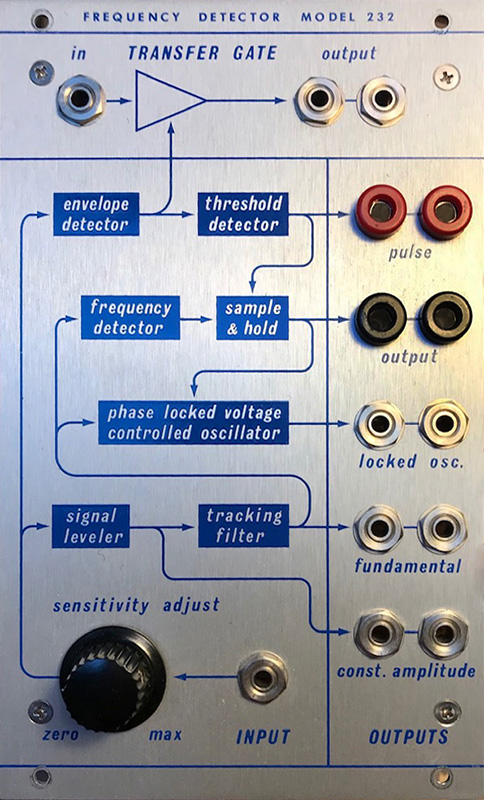
Construction
I didn't disassemble the early version 232 so didn't take photos of the front panel wiring and PCB1. This module was wired the same. The two black banana jacks should be for the CV output. However, the early 232 was modified and the 232M wired the same. The gray/blk wire is the CV output from the PLL so it increases with frequency. The blue wire is the standard CV output.
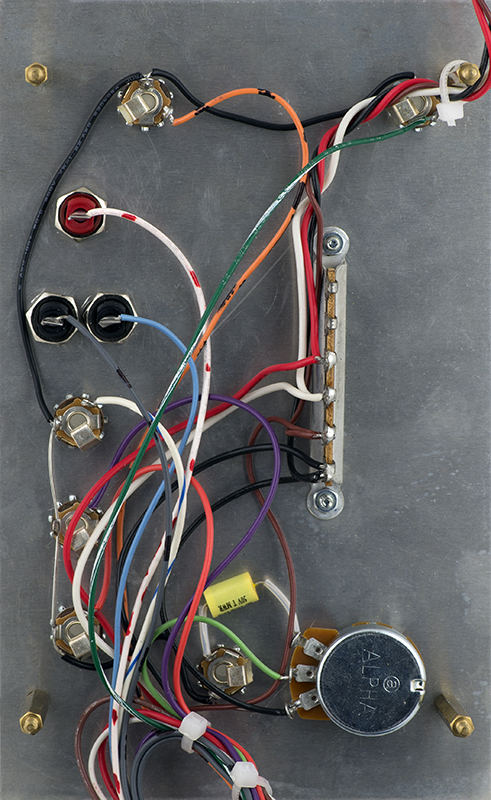
PCB1 contains the signal leveler, tracking filter, and CV generation circuits.
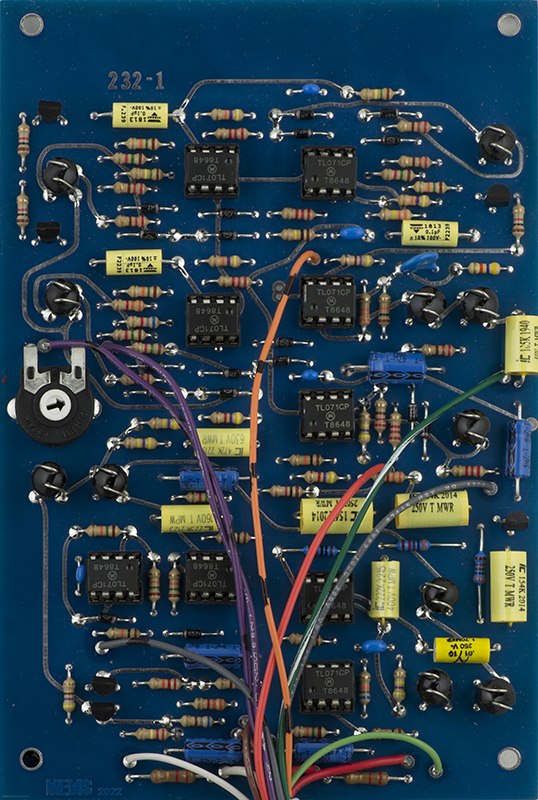
PCB2 contains the phase locked loop, VCO, and CV sample & hold along with my CV modification.
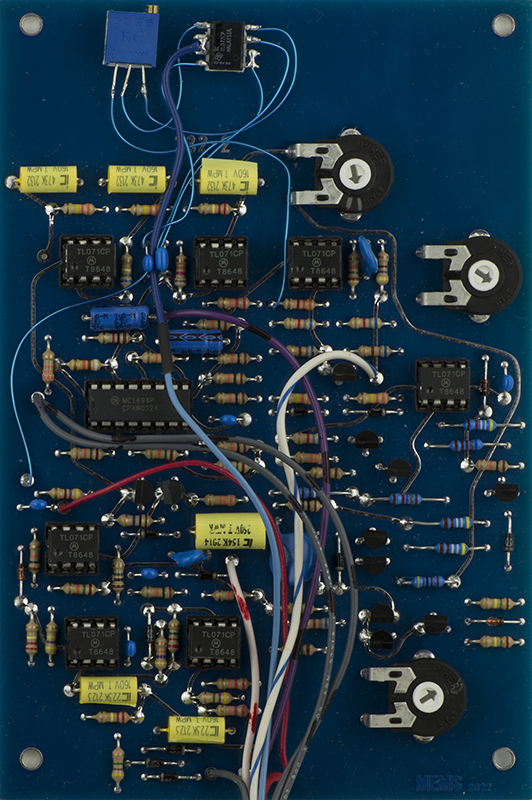
Modifications
This module does not include the 33K resistor which was added to the rear of PCB2 on the CV circuitry on the early 232. I didn't add it but instead added a buffer followed by a variable gain stage to adjust it to 1.2V/Oct. While close, it doesn't track linearly although the average strangely is 1.199V.
| Frequency | Voltage | V/Octave |
| 100 Hz | 1.426 | |
| 200 Hz | 2.612 | 1.186 |
| 400 Hz | 3.817 | 1.205 |
| 800 Hz | 4.995 | 1.178 |
| 1600 Hz | 6.222 | 1.227 |
Calibration
These images show the location of the various trimmers.
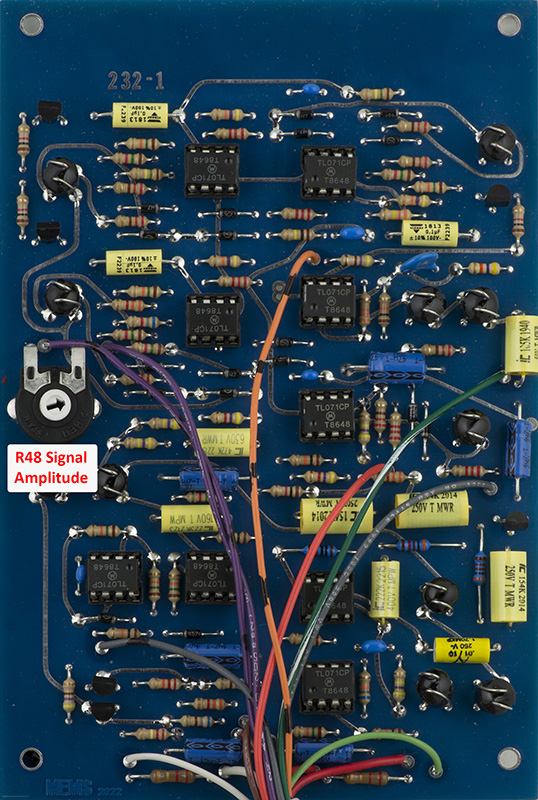
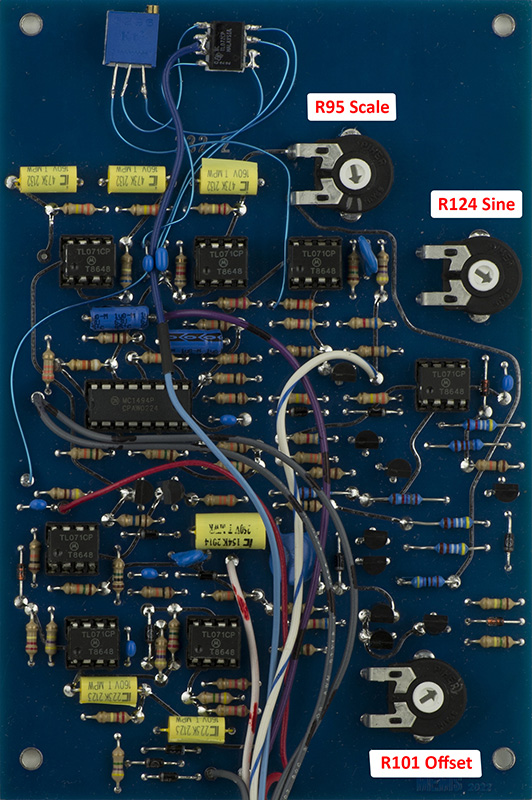
The signal amplitude R48 notes in the schematic has different descriptions. (1) adjust for maximum signal level at the gray wire (C8+) at 1 KHz input, and (2) adjust for maximum signal at the output of IC2 (pin 6). This is the output of the signal leveler so adjustment should be made for maximum signal level over the input signal frequency range. I set the input frequency to 4V pk-pk 1000 Hz sine found very little difference in the trimmer so set it to maximum at full CCW when viewed from the rear.
I patched the input signal and the Locked Oscillator output to a mixer and monitored both on an oscilloscope. I set the Sensitivity Adjustment control to full maximum, centered the scale trimmer, and set the input frequency to 150 Hz. I adjusted the offset until the Locked Oscillator locked to the input.
The rest of the calibration is iterative. I slowly increased the VCO frequency and when the Locked Oscillator lost sync I would carefully adjust the scale trimmer to lock, making only small adjustments. If I couldn't get it to lock, then I'd make a slight adjustment on the offset trimmer. I kept repeating this until I achieved a range of ~80 Hz to ~1500 Hz. Check the range of operation to see if it tracks 80 to your maximum. I achieved 1500 to 2500 Hz on different modules.
Adjust the Sensitivity Adjustment to as low as possible to still track the input frequency. I then patched the VCO to my keyboard and alternated octaves in the middle of the frequency range. The locked oscillator takes just a bit to synchronize and required some further tweaks of the offset and scale trimmer.
Operation
I was able to adjust this module to operate over the specified range of 80 Hz to 2500 Hz. I first tried scaling with the MC1494 removed and was able to get the locked oscillator to track over a fairly wide range. However, when the MC1494 was inserted it wouldn't lock so I adjusted the level trimmer on PCB1 to maximum and then adjusted the scale and offset trimmers until it tracked. See below for calibration.
At 67 Hz the locked oscillator is showing some distortion.
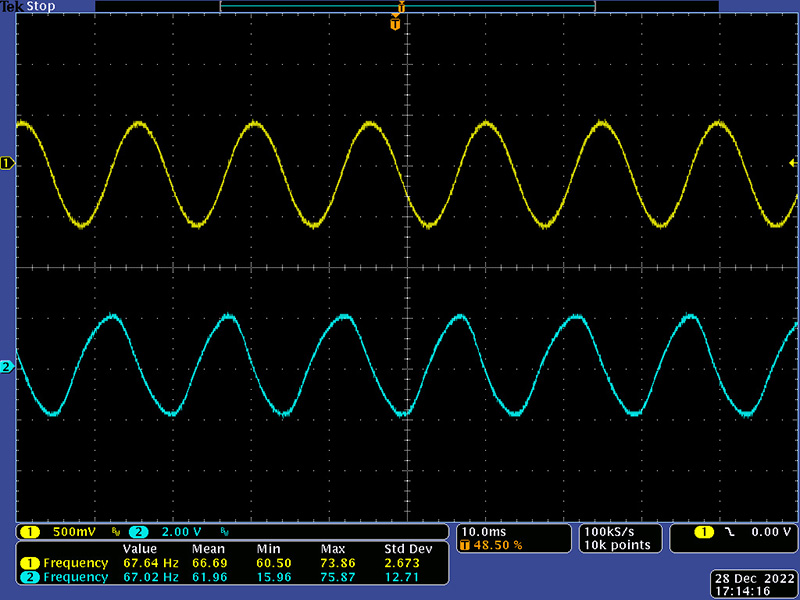
By 70 Hz the locked oscillator sine wave looks good.

This scope image shows the maximum locked frequency of 2500 Hz.
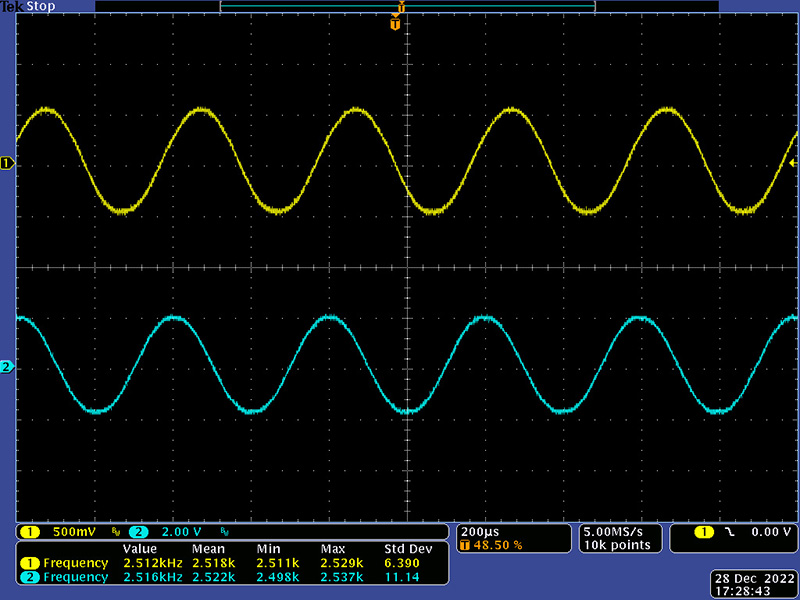
The responsiveness of the MEMS 232M is much better than the early version 232. Vactrols are used in the tracking filter and I suspect the new MEMS vactrols are more responsive which helps the filter sweep faster. In addition, the early version 232 vactrols are 50+ years old and my experience is they do change over time. A two octave change does require some time to lock so the "whoops" can be heard.
In this video I have my Arturia keyboard setup with a sequence of scaling down 2 octaves, then a note an octave up, and then repeat. The note in the middle does minimize the "whoops" with the locked oscillator tracking.
The square wave (yellow) is a 258 VCO signal input, the sine wave (cyan) is the locked oscillator output, and the ramp wave (magenta) is the second 258 driven by my modified 1.2V/Oct CV out. The locked oscillator tracks the input very well. The CV Out drives the second VCO reasonably well over this range although it varies somewhat depending on the magnitude.
The audio is all three waveforms and sounds reasonably in tune.